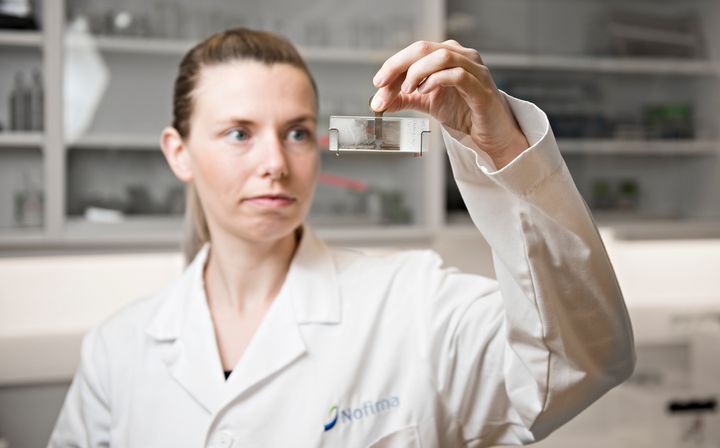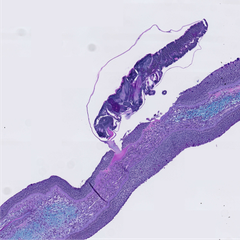Salmon have 48 hours to defeat sea lice
New scientific findings highlight the early immune response as the key to natural sea lice resistance in salmon.

“When sea lice attach, certain Pacific salmon species mount a rapid and robust response, causing the lice to fall off,” explains Lene Sveen at Nofima – the Norwegian Institute of Food, Fisheries and Aquaculture Research.
Sveen is the lead author of a recent scientific publication that closely examines the interaction between sea lice and salmon. Sea lice remain one of the aquaculture industry's most significant challenges, and scientists are working tirelessly to develop knowledge that could lead to new solutions.
In a recent study, Sveen and her colleagues focused on coho salmon - long recognised for its natural resilience against sea lice. Rather than analysing the entire immune system, the scientists focussed on the site where the louse first attaches to the skin - a decision that proved to be a good idea.
“This is precisely where the battle begins. If the salmon can respond quickly enough, it can prevent the louse from gaining a foothold,” says project leader Nick Robinson at Nofima.
The scientists discovered that coho salmon trigger a powerful inflammatory reaction within two days of louse attachment. Immune cells flood the louse attachment area, making it difficult for the parasite to establish itself. In contrast, Atlantic salmon show a much weaker response.
Not only coho salmon, but also other Pacific species such as chum and pink salmon, demonstrate impressive defences against sea lice. The study reveals that these species have a high density of mucous cells in their skin. During the experiment, the salmon had to be anaesthetised for the sea lice to attach successfully.
“This suggests that their skin surface is inherently unsuitable for the parasite in some of these other species, and that several mechanisms are at play, making it difficult for lice to successfully establish,” Sveen explains.
Comparing Pacific and Atlantic salmon
The research was conducted as part of the CrispResist project, which brings together an international team of experts from both science and industry. For four years, they have sought answers as to why some Pacific salmon species are more resistant to sea lice than Atlantic salmon. Their efforts have been cumulative, and much of the pieces in the puzzle are now in place.
“We have never been closer to the answer about how species like coho defeat sea lice, and these new findings have sparked several new ideas for further research that will bring us closer to solutions for Atlantic salmon,” says Sveen.
- Publication reference: Local inflammation at the salmon louse (Lepeophtheirus salmonis) attachment site contributes to copepodid rejection in coho salmon (Oncorhynchus kisutch).
About the project
The aim of CrispResist is to identify the underlying mechanisms behind species-independent variation in host resistance to sea lice, using this knowledge to enhance resistance in Atlantic salmon.
The partners in the project is Nofima, University of Edinburgh, University of Prince Edward Island, University of Stirling, Bigelow Laboratory of Ocean Sciences, University of Bergen, University of Gothenburg, Rothamsted Research, Institute of Marine Research, Deakin University, Benchmark Genetics, Mowi, and Salmar. It is funded by FHF – The Norwegian Seafood Research Fund.
Keywords
Contacts
Reidun Lilleholt Kraugerud
Tel:48197382reidun.lilleholt@nofima.noImages
Links
About Nofima
The Norwegian food research institute Nofima provides research based knowledge and innovations for actors in all parts of the food systems.

Subscribe to releases from Nofima
Subscribe to all the latest releases from Nofima by registering your e-mail address below. You can unsubscribe at any time.
Latest releases from Nofima
Laksen har 48 timer på seg til å vinne mot lakselusa13.6.2025 09:13:42 CEST | Pressemelding
Ny forskning peker på tidlig immunrespons som det viktigste elementet for naturlig luseresistens hos laks.
New research illuminates the needs of farmed salmon12.6.2025 10:57:22 CEST | Press release
Scientists in Norway have begun examining how farmed salmon and rainbow trout perceive the light in their environment. Their aim is to provide recommendations to fish farmers on the use of lighting from hatching to harvest for both species.
Lysmiljøet til laksefisk er nå under lupen12.6.2025 09:20:40 CEST | Pressemelding
Forskerne er nå i gang med å undersøke oppdrettsfiskens perspektiv på lyset den omgis av. De skal deretter komme med anbefaling til oppdrettere om bruk av lys fra klekking til slakt for laks og regnbueørret.
Forbrukere dropper kildesortering når det blir vanskelig4.6.2025 07:00:00 CEST | Pressemelding
En ny forbrukerstudie fra Nofima viser at folk ønsker miljøvennlig emballasje, men når de møter emballasje som krever ekstra innsats å kildesortere lar de ofte være. De ønsker seg løsninger der bransjen tar seg av for eksempel separasjon av emballasjen.
Forskere lager sunt laksefôr av forurensende CO23.6.2025 14:37:23 CEST | Pressemelding
Forurensende CO2 gjøres om til godt fôr til oppdrettslaks. Science fiction? Overhodet ikke. Det som skal til er tre innovative forskingsmiljø, én visjonær aktør innen tungmetallindustrien, og store mengder alger.
In our pressroom you can read all our latest releases, find our press contacts, images, documents and other relevant information about us.
Visit our pressroom


